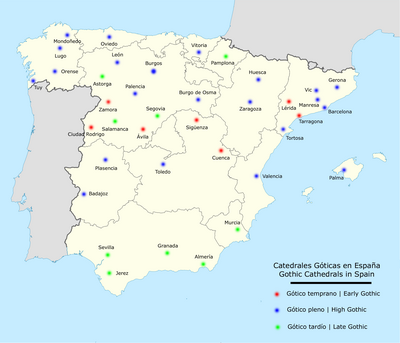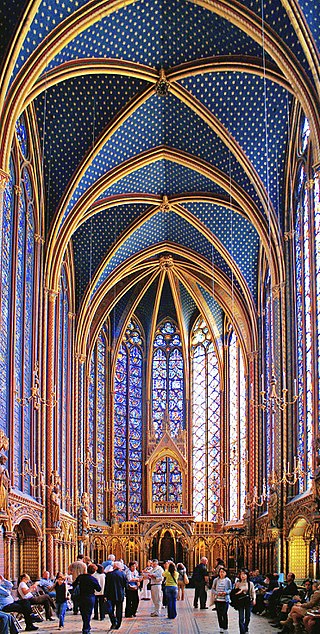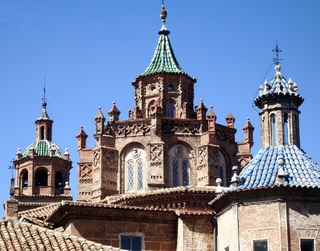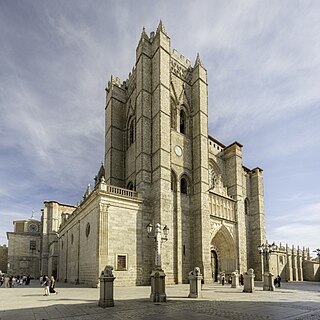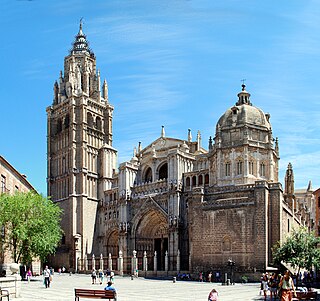
Spanish Gothic architecture is the style of architecture prevalent in Spain in the Late Medieval period.
Contents
- Key Spanish Gothic Architectural Elements
- Sequence of Gothic styles in Spain
- Examples
- Early Gothic
- High Gothic
- Mudéjar Gothic
- Valencian Gothic
- Balearic Gothic
- Catalan Gothic
- Flamboyant/Late Gothic
- Isabelline Gothic
- Modern Spanish Gothic
- Gallery
- See also
- References
The Gothic style started in Spain as a result of Central European influence in the twelfth century when late Romanesque alternated with few expressions of pure Gothic architecture. [1] The High Gothic arrives with all its strength via the pilgrimage route, the Way of St. James, in the thirteenth century. Some of the most pure Gothic cathedrals in Spain, closest related to the German and French Gothic, were built at this time.
In some cases the Gothic style was built and decorated with Mudéjar elements by Mudéjar craftsmen and Christian craftsmen influenced by them, creating a highly distinctive Gothic style unique to Spain and Portugal. [2] Some noteworthy post−thirteenth-century Gothic styles in Spain are the Levantine Gothic, characterized by its structural achievements and the unification of space, and the Isabelline Gothic, under the Catholic Monarchs, that predicated a slow transition to Renaissance architecture. Gothic construction ended in Spain in the sixteenth century. [2]

In 1172, French architect Giral Fruchel designed the first ever Gothic cathedral in Spain. [4] Ávila Cathedral, a cathedral located in Central Spain, represents a blend of the Romanesque and Gothic styles. [4] Alfonso VIII, former King of the Castile Kingdom, was inspired by the Basilica St. Denis in France and wanted Ávila's plan to incorporate double ambulatory and radiating chapels. [5] A double ambulatory consists of an apse that is surrounded by two walkways. [6] Radiating chapels, are small, semicircular chapels that appear along the apse of a church. [6] Alfonso's wish was granted, as Ávila Cathedral embodies these characteristics.

In 1227, Archbishop Rodrigo Jimenez de Rada initiated the rebuilding of the Toledo Cathedral in the Gothic style as well. [7] Prior to this reconstruction, Toledo was under Muslim control and possessed Islamic architectural elements. [6] Toledo's ground plan, for instance, resembled the ground plan of a mosque. [7] The fusion of Islamic and French Gothic influences gave rise to a distinctive and uniquely Spanish Gothic architectural style, and Toledo Cathedral was among the first to exhibit this. [8] Other physical attributes that Toledo Cathedral possesses are great bronze doors that make up the central portal of the building, plain vaults, double staggered aisles, and elaborate stonemasonry with colored marbles. [8] Toledo is a monumental Gothic cathedral and represents architectural experimentation, [8] as this was built during the upsurge of Gothic architecture in Spain.
Similar to Toledo, Burgos Cathedral was constructed in the early thirteenth century, in 1221. Both Toledo and Burgos Cathedrals have been altered many times since their initial construction. [9] However, Burgos Cathedral is still deemed a favorable example of High Gothic Spanish architectural style. [10] This cathedral incorporates flying buttresses, clerestory windows, pier arches, and a rose window. [11] In addition to this, the choir in Burgos Cathedral is located in the center of the nave. [11] This was unique because most gothic cathedrals positioned the choir in between the nave and the altar. [12] Burgos Cathedral also contains vaults that are slightly domical and diagonal ribs. [11] These key attributes suggest that the architects of this structure were influenced by French Gothic architecture. [13]
In the fourteenth century, Spain started to introduce ornate features in their Gothic structures. [6] Catalonian architecture, architecture belonging to the Catalonian region in northeastern Spain, was seen as superior during this time due to their frequent use of design elements. [6] The Chapel of Santa Ágata in the Royal Palace of Barcelona, constructed from 1303 to 1310, exhibits double windows, polished contours, and refined proportions. Similar to other Gothic cathedrals, the Chapel of Agueda displays stained glass windows as well as religious iconography. [6] These features highlight the artistry of Spanish Gothic architecture that can still be seen in architectural design today. The Ace Hotel in Los Angeles is an example of Spanish Gothic influence in contemporary time. [14]


